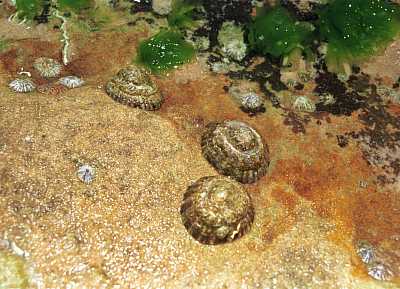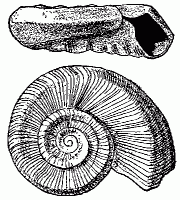
Cellana tramoserica (Holten, 1802)
Patellogastropoda - Nacellina - Nacelloidea - Nacellidae
Patty Jansen - Capricornica Publications
| Gastropoda | ||
| Mollusca | Eogastropoda |
Gastropoda
└─► |
|||
|
Abbreviated Dendrogram
Mollusca
├─Aculifera
└─Conchifera
╘═Helcionelloida
└─┬─Bellerophontoidea
└─Gastropoda (crown group)
╞═Eogastropoda (paraphyletic or polyphyletic?)
│ ├?─Macluritoidea
│ ├?─Euomphaloidea
│ └─Patellogastropoda
└─Orthogastropoda
├─Vetigastropoda
├─Neritimorpha
└─┬─Caenogastropoda
└─Heterobranchia
├─Opisthobranchia
└─Pulmonata
|
Contents
Index |
 |
Cellana tramoserica (Holten, 1802) Patty Jansen - Capricornica Publications |
 |
Euomphalus pernodosus image © McGraw Hill Book Company, from Moore, et al. 1952, p.306 |
The clade Eogastropoda was defined by Ponder and Lindberg 1997 to distinguish the most primitive gastropods from their more derived cousins. This was based on the argument that the limpets (Patellacea/Patelloidea/Patellina), originally classified as "archaeogastropods" because of soft-part anatomy [Moore, et al. 1952, p.309 ], and considered specialized descendants of
Pleurotomariaceans, are actually a group of much more primitive survivors from the original gastropod radiation. There are a number of reasons for this. Limpets retain the same docoglossa-type radula as Polyplacophora and Scaphopoda, whereas other "archaeogastropods" have a rhipidoglossa type of radula [Golikov and Starobogatov 1975). They also have much more primitive eyes and other characteristics. Lindberg 1988, Haszprunar 1988, Ponder and Lindberg 1997, Sasaki 1998 and others all argue that the patelloids - now called Patellogastropoda or Doccoglossa - are the sister taxon of all other extant gastropods. Phylogenetic analyses of partial 18S rDNA sequences indicate that the Patellogastropoda comprises a robust clade with high statistical support [M. G. Harasewych, A. G. McArthur, A molecular phylogeny of the Patellogastropoda (Mollusca: Gastropoda)]
Because the Eogastropoda includes not only extant species but also many extinct (mostly Palaeozoic forms, e.g. Euomphalus, shown left) as well, most of which look nothing at all like modern limpets, and probably had very different habits as well, it can better be defined cladistically as a "stem group" taxon - i.e. all gastropods more similar to (say) Patella than to (say) Helix, rather than a "crown group" definition (the common ancestor of all extant limpets and its descendants). For more on cladistics and how this works see this page.
In the Linnaean framework, the Eogastropoda is a subclass, the counterpart of the Orthogastropoda (which includes all other gastropods). Possibly other extinct groups, like the Bellerophontoidea, might belong under their own subclass
Range: Latest Cambrian (Late Dolgellian Age) to Recent; Worldwide
Gastropoda : Orthogastropoda + Eogastropoda : Euomphaloidea ::: Patellogastropoda
the following primitive soft-body characteristics of the Patellogastropoda may also apply to the earliest Eogastropoda: $ the shallow mantle cavity; $ ctenidium without skeletal rods; $ paired excretory system; $ simple eye type; $ position of statocysts, (all from Haszprunar 1988 p.9], $ primitive-type sperm morphology (Koike, 1985; Healy, 1988; 1996), $ osphradium lacking true sensory cells; $ double-layered jaw plate (shared by Patellogastropoda and Cephalopoda) Sasaki 1998, primitively, paired and equal ctenidia and other organs [Knight, et al., 1960], some body asymmetry in later forms.
Taxon Rank: Subclass [Jeffery 2001]
Comment: may be paraphyletic orf polyphyletic as originally defined. Nevertheless there is a similarity between euomphalid and contemporary patellogastropod protoconches.
page uploaded 6 March 2003
checked ATW050825
original material Creative Commons Attribution M. Alan Kazlev
this material may be freely used
all other material © original authors or sources